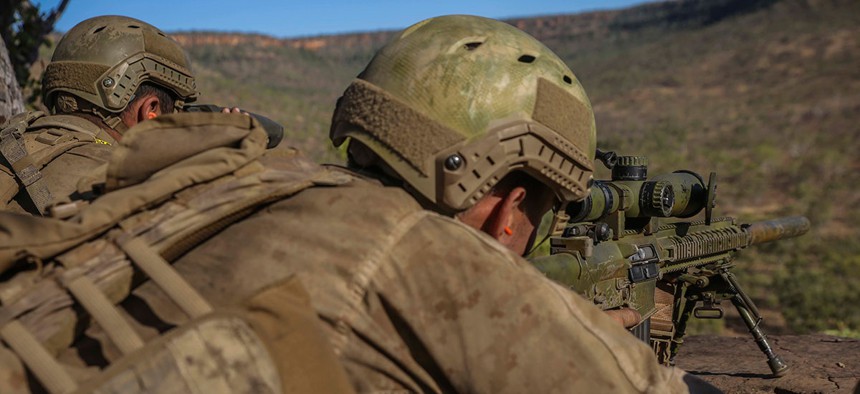
Marines participate in a training session in July. Cpl. Ryan C. Main/Marines
The Marines Tested Totally Male Squads Against Mixed-Gender One
The results were pretty bleak.
In 2013, the US military lifted its ban on women serving in combat. Shortly after, the Marine Corps began what it calls an “unprecedented research effort” to understand the impact of gender integration on its combat forces. That took the form of a year-long experiment called the Ground Combat Element Integrated Task Force, in which 400 Marines—100 of them female—trained for combat together and then undertook a simulated deployment, with every facet of their experience measured and scrutinized.
All branches of the military are facing a January 1, 2016, deadline to open all combat roles to women. The Marine Corps is using this experiment to decide whether to request exceptions to that mandate.The Corps’ summary of the experiment, posted online today by NPR, concludes that combat teams were less effective when they included women.
Overall, the report says, all-male teams and crews outperformed mixed-gender ones on 93 out of 134 tasks evaluated. All-male teams were universally faster “in each tactical movement.” On “lethality,” the report says:
All-male 0311 (rifleman) infantry squads had better accuracy compared to gender-integrated squads. There was a notable difference between genders for every individual weapons system (i.e. M4, M27, and M203) within the 0311 squads, except for the probability of hit & near miss with the M4.
And:
All-male infantry crew-served weapons teams engaged targets quicker and registered more hits on target as compared to gender-integrated infantry crew-served weapons teams, with the exception of M2 accuracy.
And:
All-male squads, teams and crews and gender-integrated squads, teams, and crews had a noticeable difference in their performance of the basic combat tasks of negotiating obstacles and evacuating casualties. For example, when negotiating the wall obstacle, male Marines threw their packs to the top of the wall, whereas female Marines required regular assistance in getting their packs to the top. During casualty evacuation assessments, there were notable differences in execution times between all-male and gender-integrated groups, except in the case where teams conducted a casualty evacuation as a one-Marine fireman’s carry of another (in which case it was most often a male Marine who “evacuated” the casualty)
The report also says that female Marines had higher rates of injury throughout the experiment.
Such conclusions may be disheartening to proponents of gender integration in combat, and certainly put a damper on the news that the Army’s ranger school recently graduated its first female soldiers. The tests come with at least one important caveat: As the Marine Corps Times notes, many of of the male study participants had previously served in combat units, whereas female participants, by necessity, came directly from infantry schools or from noncombat jobs.
The Marine Corps summary report does not indicate or suggest that the Marines will be asking for an exception to the military’s integration mandate. However, it does quote this somber section of a 1992 government study on gender integration in the armed forces:
A military unit at maximum combat effectiveness is a military unit least likely to suffer casualties. Winning in war is often only a matter of inches, and unnecessary distraction or any dilution of the combat effectiveness puts the mission and lives in jeopardy. Risking the lives of a military unit in combat to provide career opportunities or accommodate the personal desires or interests of an individual, or group of individuals, is more than bad military judgment. It is morally wrong.






